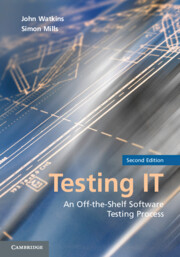Book contents
- Frontmatter
- Contents
- Foreword to the Second Edition by Geoff Thompson
- Foreword to the First Edition by Maurice Rosenburgh
- Acknowledgments
- 1 Introduction
- PART 1 THE TRADITIONAL TESTING PROCESS
- PART 2 THE TESTING PROCESS IN THE REAL WORLD: ILLUSTRATIVE CASE STUDIES
- PART 3 THE APPENDICES
- Appendix A Terms of Reference for Testing Staff
- Appendix B Testing Guides
- Appendix C Test Plan Document Template
- Appendix D Test Specification Document Template
- Appendix E Test Script Template
- Appendix F Test Result Record Form Template
- Appendix G Test Log Template
- Appendix H Test Certificate Template
- Appendix I Reuse Pack Checklist
- Appendix J Test Summary Report Template
- Appendix K Equivalence Partition Example
- Appendix L Boundary Value Analysis Example
- Appendix M State Transition Example
- Appendix N Pairwise Testing Example
- Appendix O Automated Testing Tool Selection Criteria
- Appendix P Usability Testing Overview
- Appendix Q Testing Process Health Check
- Appendix R The Testing of Object-Oriented Software
- Appendix S Pragmatic Test Process Adoption – a Real-World Example
- References
- Glossary
- Index
Appendix J - Test Summary Report Template
Published online by Cambridge University Press: 03 May 2011
- Frontmatter
- Contents
- Foreword to the Second Edition by Geoff Thompson
- Foreword to the First Edition by Maurice Rosenburgh
- Acknowledgments
- 1 Introduction
- PART 1 THE TRADITIONAL TESTING PROCESS
- PART 2 THE TESTING PROCESS IN THE REAL WORLD: ILLUSTRATIVE CASE STUDIES
- PART 3 THE APPENDICES
- Appendix A Terms of Reference for Testing Staff
- Appendix B Testing Guides
- Appendix C Test Plan Document Template
- Appendix D Test Specification Document Template
- Appendix E Test Script Template
- Appendix F Test Result Record Form Template
- Appendix G Test Log Template
- Appendix H Test Certificate Template
- Appendix I Reuse Pack Checklist
- Appendix J Test Summary Report Template
- Appendix K Equivalence Partition Example
- Appendix L Boundary Value Analysis Example
- Appendix M State Transition Example
- Appendix N Pairwise Testing Example
- Appendix O Automated Testing Tool Selection Criteria
- Appendix P Usability Testing Overview
- Appendix Q Testing Process Health Check
- Appendix R The Testing of Object-Oriented Software
- Appendix S Pragmatic Test Process Adoption – a Real-World Example
- References
- Glossary
- Index
Summary
Introduction
This appendix contains a test summary report template, which may be copied and used as the basis of a test summary report for a particular test phase. The purpose of a test summary report is to summarize the result of a particular testing phase and to provide the basis for subsequent improvement of the testing process. An electronic version of the template can be obtained using the following link: http://www.cambridge.org/9780521148016.
As described in Chapter 4 (The Management and Planning of Testing), each testing project must generate a test summary report as one of the documents produced at the conclusion of any given testing phase.
Where text appears within the body of this template in angle brackets (< >), this denotes a place marker, which must be replaced with the appropriate information for a particular testing phase.
Text that appears in italic is provided for information only (such as illustrative examples) and should not appear in the final test summary report.
The principal approach to be used in writing a test summary report is to try to produce a succinct document. Make best use of the supporting information presented in this book (such as the other relevant templates), as well as pertinent material from the appropriate testing phase chapters.
Where the template provided in this appendix does not precisely match the requirements of a particular testing project, the test team leader should obtain an electronic copy of this template and modify it as required.
- Type
- Chapter
- Information
- Testing ITAn Off-the-Shelf Software Testing Process, pp. 261 - 267Publisher: Cambridge University PressPrint publication year: 2010

